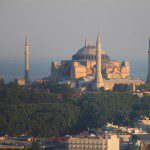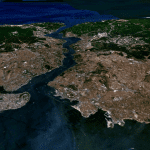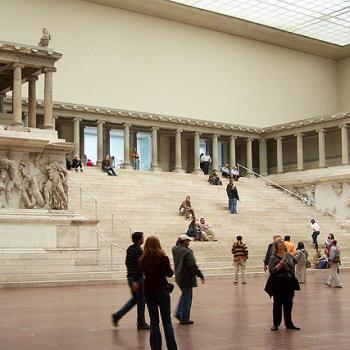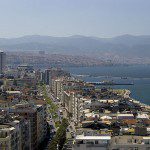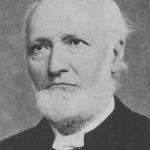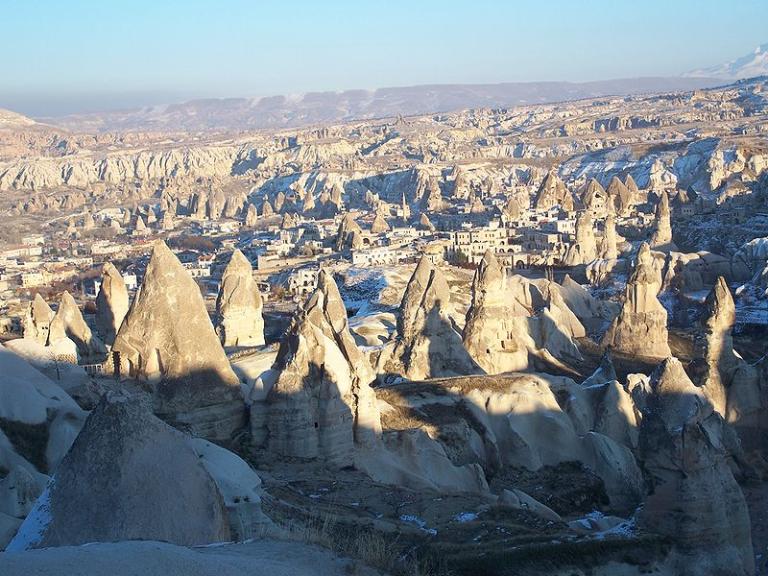
We spent the night in Adana, a very old city that is mentioned not only in Homer but in the famous ancient Mesopotamian Epic of Gilgamesh.
I’ve never before been to Tarsus, so I’ve been looking forward to today.
The city is located on the mouth of a river that empties into the Mediterranean. Anciently, that river was called the Cydnus, but is now known as the Berdan. Tarsus is also located at the southern end of the Cilician Gates (the only major pass through the Taurus Mountains) and it has an excellent harbor at Rhegma. Thus, it sits at the junction of land and sea routes that connected the Cilician plain (known today as Çukurova), central Anatolia, and the Mediterranean Sea—particularly the Levant, which may explain why the parents of the Apostle Paul settled there. Perhaps because of its siting near a river mouth, Tarsus was surrounded by exceptionally rich and fertile soul, which was a major source of its prosperity between the fifth century BC and the Arab invasions in the seventh century AD.
It’s a very old place. Signs of settlement have been found that date all the way back to the Neolithic period, the New Stone Age. The first historical record of Tarsus is its rebuilding by the Assyrian king Sennacherib (who reigned 705/704-681 BC). Thereafter, periods of Achaemenid and Seleucid control alternated with periods of autonomous self-rule.
In 67 BC, Tarsus was absorbed into the new Roman province of Cilicia. A university was established that became famous for its flourishing school of Greek philosophy. The traditional tomb of the biblical Daniel is located here, as is, it seems, the genuine tomb of the extremely important ‘Abbasid Muslim caliph al-Ma’mun (reigned AD 786-833).
Most famously, perhaps, Saul of Tarsus—the future Apostle Paul—was born and raised here, though he also spent substantial time being educated in Jerusalem, which made him literally and culturally bilingual and, thus, an extraordinarily effective messenger in taking Christianity to the Gentiles:
“I am a man which am a Jew of Tarsus,” he said, “a city in Cilicia, a citizen of no mean city” (Acts 21:39).
Less well known is the connection of Tarsus with the Roman politician and general Marcus Antonius—better known in English as Mark Antony—and Cleopatra VII Thea Philopator (“Cleopatra [‘Famous in Her Father’] the Father-Loving Goddess”). Yes, of course: The Cleopatra.
Antony, who had been a strong supporter of his relative Julius Caesar, first met Cleopatra when she was young, while he was campaigning in Egypt in 55 BC. Then he met her again in 48 BC, when Julius Caesar had backed her as queen of Egypt over the claims of her half-sister Arsinoe. Famously, Caesar and Cleopatra had an affair, which resulted in a son, Caesarion, who was born in BC 47. She and her son lived in Rome as Caesar’s guests until BC 44, when he was assassinated. At that point, she and Caesarion returned to Egypt, where she named the boy as her co-ruler.
Also after that famous assassination, Antony joined forces with Lepidus, another of Caesar’s generals, and Octavian, Caesar’s great-nephew and adopted son. They formed a three-man dictatorship that is known to historians as the “Second Triumvirate.” The Triumvirs proceeded to defeat Caesar’s killers, the so-called Liberatores, at the Battle of Philippi in 42 BC, and then they divided the government of the Roman Republic—it was still nominally a republic—between themselves. Antony was assigned Rome’s eastern provinces, which included the client kingdom of Egypt, ruled at the time by . . .Cleopatra.
In October of 41 BC, Antony requested that Cleopatra, Rome’s chief eastern vassal, meet him at Tarsus in Cilicia.
She arrived in Tarsus aboard a magnificent ship, and invited Antony to a grand banquet to solidify their alliance. This was extremely important to him: She was the most powerful of Rome’s eastern vassals, and her support was indispensable to Rome’s planned military invasion of the Parthian Empire, which had been entrusted to him. At Cleopatra’s request, Antony ordered the execution of her half-sister Arsinoe, who had been granted sanctuary at the great temple of Artemis in Ephesus.
But the visit went beyond normal diplomacy and power politics. Antony and Cleopatra spent the winter of 41 BC together in Alexandria, where she bore him twins, Alexander Helios and Cleopatra Selene II, in 40 BC.
Relations among the triumvirs, though, were becoming more and more strained, and civil war between Antony and Octavian very nearly broke out in 40 BC. It was averted partly because Antony married Octavian’s sister, Octavia.
Despite the marriage, though, Antony carried on with his love affair with Cleopatra, which didn’t exactly help his relationship with Octavian. A third child, Ptolemy Philadelphus, was born to Antony and Cleopatra in 36 BC, the same year that Lepidus was purged from the three-man dictatorship. Finally, civil war broke out in 31 BC between Antony and Octavian as the Roman Senate, directed by Octavian, denounced Antony as a traitor and declared war against Cleopatra. Later that same year, Antony’s forces were defeated by Octavian’s at the Battle of Actium. Antony and Cleopatra fled to Egypt where, after another defeat at the Battle of Alexandria, they committed suicide.
Upon Antony’s death, Octavian had become the undisputed master of Rome. In BC 27, he was granted the title of Augustus. He would also be known as Caesar, because of his relationship to his great uncle and adoptive father, Julius Caesar. He was the first Roman emperor. The Roman Republic was dead.
We had lunch in Tarsus after visiting “Cleopatra’s Gate,” by which, according to tradition, the Egyptian queen entered the city in order to meet with Mark Antony, and after paying our respects to the traditional “well of St. Paul” – from which he may or may not ever have drawn or tasted water, but which is, as it happens, likely old enough to have served the purpose.
From Tarsus, we drove on, through multiple tunnels and a landscape very reminiscent of Utah, to the fabled district of Cappadocia. Here, we’re spending a couple of nights in a “cave hotel.”
Posted from Ürgüp, Cappadocia, Türkiye


